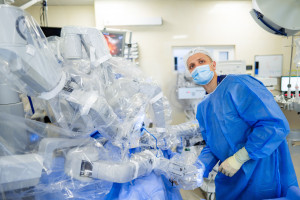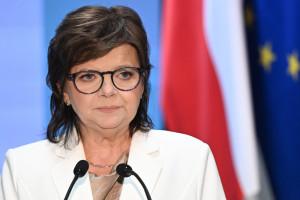Most Popular Robotic Procedure Costs Too Much. Do the Benefits Justify the Cost?

- The Agency for Health Technology Assessment and Tariff System in a report for the Ministry of Health stated that the valuation of radical prostatectomy using a robotic system is too high
- There have been voices in the industry for a long time that valuations will be revised. Robotics costs the state a fortune and the market is constantly growing
- Rynek Zdrowia's editorial team analyzed data on the costs and benefits of using modern surgical devices. We present the results of our analysis
"The analyses carried out indicate that the current level of reimbursement in the L31R group Radical prostatectomy using a robotic system is higher than the costs incurred, which is related to the increase in the point price over the last years and the high share of the costs of medical devices in the total cost of services in this area," writes the Agency for Health Technology Assessment and Tariff System in a report commissioned by the Ministry of Health .
AOTMiT indicates that in the first quarter, procedures involving the robotic system were the leading overperformance, amounting to 87% in relation to the contracted value. This means that hospitals performed almost twice as many robotic surgeries as their contract with the National Health Fund provided for (the cost of overperformance alone for this period was almost PLN 57.4 million ).
The AOTMiT report may herald what has been said behind the scenes for some time: that the pricing of procedures involving surgical robots is too high and should be reduced.
Market observations show that the attractive pricing of this type of surgery, in addition to the rapid increase in its availability to patients within the public healthcare system, has led to a number of other events.
Firstly, it influenced the decision to purchase such devices by hospitals that did not conduct a thorough analysis of needs and later have problems with ensuring the appropriate number of procedures performed and - thus - maintaining their high quality.
Secondly, which is only whispered about at conferences, resulted in increased qualification of patients for radical prostatectomy procedures. According to some experts, the increase in the number of surgeries is disproportionate to the epidemiological data.
Third, pricing has led to the emergence of "traveling cutters" on the market. We are talking about experienced robotic system operators who - acting like mercenaries - perform procedures in various hospitals, then leave patients under the care of local doctors. According to Prof. Piotr Chłosta, head of the Department and Clinic of Urology at the Jagiellonian University Medical College in Krakow, this is "conduct contrary to medical ethics".
Currently, the National Health Fund applies higher pricing for three types of robotic procedures:
- radical prostatectomy (reimbursement cost approx. PLN 32,700 ),
- treatment of malignant tumor of the uterus ( PLN 36,600 ),
- treatment of malignant tumors of the large intestine ( PLN 37,900 ).
In discussions about the use of financing for robot-assisted procedures, another fundamental question is still smoldering. Namely: are the benefits of their use adequate or more important than the valuations? The costs of robotic procedures are twice as high as in the case of the open method and almost 50 percent higher than in the case of laparoscopy.
The editorial team of Rynek Zdrowia has applied to the National Health Fund for statistics on radical prostatectomy procedures, as it was for this type of surgery that a separate valuation for the use of robotic systems was first introduced. This has resulted in the fact that most radical prostatectomies are currently performed using modern devices.
We learn that in 2024 the following was done:
- 8546 robot-assisted radical prostatectomy procedures,
- 4377 laparoscopic procedures,
- 1010 open procedures.
The cost of reimbursement of treatments was:
- PLN 278.5 million for robotic operations,
- PLN 111.4 million for laparoscopy,
- PLN 16.9 million for the open method.
The average length of hospital stay of patients after the procedure was:
- 4.75 after robotic procedure.
- 5.67 after laparoscopy,
- 7.98 for the open method.
Mortality after prostatectomy within 30 days of hospitalization was:
- 0.02% after robotic surgery,
- 0.14% after laparoscopy,
- 0.20% after the open method.
The number of procedures for which the patient was rehospitalized within 60 days after the procedure was:
- 913 after robotic surgery ( 10.68% ),
- 562 after laparoscopy ( 12.83% ),
- 127 after the open method ( 12.57% ).
Value of reimbursement of services provided to patients within 60 days after the procedure (excluding the costs of products issued on request):
- PLN 14.8 million after robotic surgery,
- PLN 8.2 million after laparoscopy,
- PLN 1.8 million after the open method.
After robotic procedures, patients used primary care and advanced urological consultations more often than after laparoscopy. This may suggest more planned, follow-up visits, not necessarily resulting from a greater number of complications. Physiotherapy was needed slightly less often after robotic procedures than after laparoscopy.
We also checked another issue. Namely, after radical prostatectomy, one of the complaints of patients is - most often temporary - urinary incontinence. Manufacturers of surgical robots claim that thanks to the precision provided by their devices, problems in this area occur much less often.
To verify this, we asked the National Health Fund about the value of reimbursement of diaper pants for patients within 60 days after the procedure. It was:
- PLN 509.2 thousand after robotic surgeries (on average approx. PLN 59.50 per procedure of this type),
- 372.7 thousand after laparoscopy ( approx. PLN 85.1 ),
- 75.3 thousand after the open method ( PLN 74.6 ).
The presented statistics do not fully reflect the complexity of the subject. We hear from NHF experts that when the patient profile is compared more closely, the "gain" from using robots is not much greater than in the case of laparoscopic surgery, but noticeable. However, the comparison gives a certain picture of the benefits and costs associated with the implementation of a separate valuation of robotic procedures.
There is no doubt that the costs of such operations are very high (according to AOTMiT - too high). The use of robots slightly shortens the hospitalization time, although from an economic perspective, it does not necessarily justify the cost of the robotic procedure. However, the benefits can also be seen in other areas: lower mortality, number of complications. The statistics do not mention lower blood loss, greater patient comfort and great convenience for surgeons.
While patients can count on better clinical effects in the case of robotic procedures (which is also confirmed by numerous scientific publications, but only in the case of radical prostatectomy), from the point of view of the healthcare system it is difficult to talk about spectacular, positive effects, especially if we take into account the rising costs.
It is possible that AOTMiT has "poured the foundation" for the decision to lower the valuation of robotic prostatectomy. At the same time, the Agency is still examining the possibility of introducing separate valuations for robotic procedures in the case of malignant tumors: cervix, uterine body and ovary.
The final decision on including new areas in the reimbursement, setting prices and answering the fundamental question: "Can Poland afford it?" - will fall to the Ministry of Health.
Write to the author: [email protected]
Copyrighted material - reprint rules are specified in the regulations .
rynekzdrowia












